Practice makes perfect. This also applies to our hunting dogs, especially if they are used for blood tracking. Of course, nothing beats practice. The more practice the dog has, the better. What matters is the experience. But not every handler can spend the time required to make himself and his dog as fit and stay as fit that even the heavy tracks can be managed.
What counts is that the handler is aware of his and his dogs limitations.To recognize when it is time to call the professionals.
Especially for tracking teams that are not in constant use, it is important to keep the dog in training. Unfortunately, not all dogs work on exercise tracks. One or the other has little interest to follow the exercise. The dogs know that something is faked.
Nevertheless, if you do not overdo it, the dog will do the exercise. And the main aim of these exercises is, to resist any hot tracks.
Using the following small series of images I show how to lay an exercise track. The level of difficulty can be easily varied and depends on the education of the dog.
You have the following details to vary the difficulty:
(-) weather condition (heat, rain, snow etc.)
(-) course of the track (amount and kind of changes in direction)
(-) length of the track
(-) surface (meadow, foliage, street)
(-) change of surface (how often changes the surface)
(-) Amount of spots with hair, blood, bones
(-) how old is the track
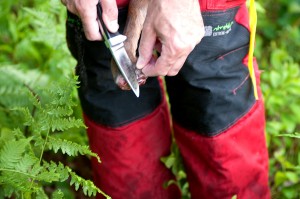 First the shooting site is simulated. Therefore I cut off a piece of skin from the hoof I will later use for the track.
First the shooting site is simulated. Therefore I cut off a piece of skin from the hoof I will later use for the track.
Then I press the skin with a stick in the ground, so that it ca not be eaten or removed by other animals until we start tracking.
When I come back later with the dog I pull the stick out. The skin is then easy to find for the dog.
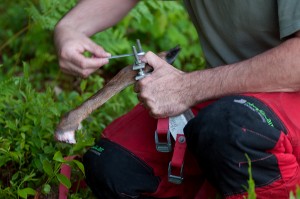 Next, the hooves are clamped in the “Faehrtenschuh”. Of course the dog will know immediately that something is wrong with this track. Therefore I use hooves which are longer (see the pictures). I expect the fact that not only the hooves leave appropriate odor, but also the leg when it contacts higher plants. If it really makes a difference, I do not know. But I think it does no harm.
Next, the hooves are clamped in the “Faehrtenschuh”. Of course the dog will know immediately that something is wrong with this track. Therefore I use hooves which are longer (see the pictures). I expect the fact that not only the hooves leave appropriate odor, but also the leg when it contacts higher plants. If it really makes a difference, I do not know. But I think it does no harm.
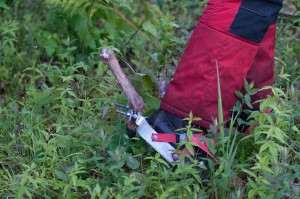 Once the hooves are clamped, it can go off. First I trample at the shooting site, making sure that an intense odor will be found by the dog. I have never used blood on exercise tracks. Neither for training nor during subsequent exercise of the already educated dog. If blood is used, you should make sure that it is sparsely sprayed or dripped. Wounded game does not lose a quarter of a gallon within 500 yards. And the blood you use should be from the same animal as the hooves. The dog notices the difference!
Once the hooves are clamped, it can go off. First I trample at the shooting site, making sure that an intense odor will be found by the dog. I have never used blood on exercise tracks. Neither for training nor during subsequent exercise of the already educated dog. If blood is used, you should make sure that it is sparsely sprayed or dripped. Wounded game does not lose a quarter of a gallon within 500 yards. And the blood you use should be from the same animal as the hooves. The dog notices the difference!
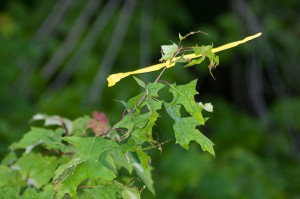 It is advisable to mark the track. The aim of the exercise is to see if the dog works the track properly. On the exercise track, the handler has the opportunity to study the behavior of his dog exactly. In contrast to the case of a real track. wherever sometimes is uncertainty, the handler should know on the exercise track at any time, if the dog is still working the right track or follows a hot track. Therefore, I mark the trail so narrow that I always see the next ribbon. I use the same ribbon that I use for real tracks. That way I train my eyes to see the marks in the woods. While tracking the marked points are important if the track is lost or it is uncertain, if the dog is still right. Then you can go back to the last known and marked point.
It is advisable to mark the track. The aim of the exercise is to see if the dog works the track properly. On the exercise track, the handler has the opportunity to study the behavior of his dog exactly. In contrast to the case of a real track. wherever sometimes is uncertainty, the handler should know on the exercise track at any time, if the dog is still working the right track or follows a hot track. Therefore, I mark the trail so narrow that I always see the next ribbon. I use the same ribbon that I use for real tracks. That way I train my eyes to see the marks in the woods. While tracking the marked points are important if the track is lost or it is uncertain, if the dog is still right. Then you can go back to the last known and marked point.
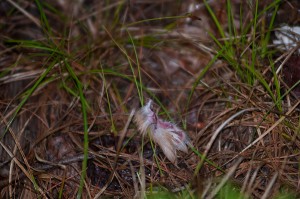 In the course of the track I create spots with skin / or wound beds. Again, I stick the skin or hair lightly in the ground, so they are still there when we work the track.
In the course of the track I create spots with skin / or wound beds. Again, I stick the skin or hair lightly in the ground, so they are still there when we work the track.
It is recommended to mark these spots separately, for example, with two ribbons. This prevents you from running through the spots and the spots are either not noticed by the dog or you did not noticed that the dog showed the spots. referenced.
At the finish the hooves used are discarded. Leaving them there together with the “Faehrtenschuh”, the human scent prevents that they are taken by other animals. To me it is still too uncertain and the risk of losing my “Faehrtenschuh” is too high. I’ll take the hooves home and bring them back, before we start tracking the other day. Doing this the track, however, should not be crossed.
